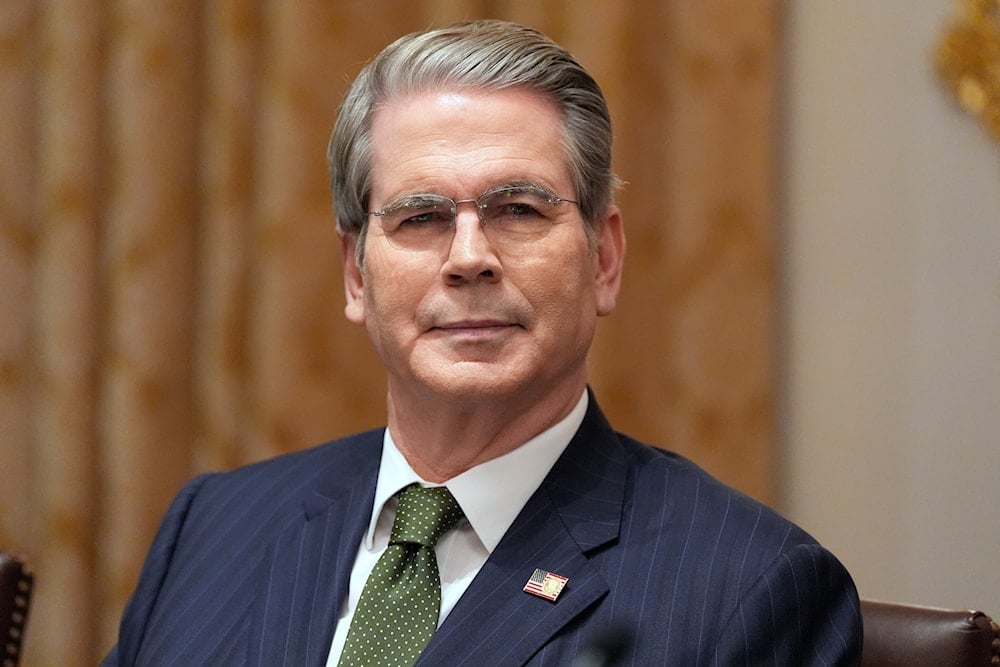US government shutdown could cost $15 bln weekly, Treasury warns
The US Treasury says the shutdown could cost $15 billion per week, as Secretary Scott Bessent cites growing economic strain.
-

US Treasury Secretary Scott Bessent listens as President Donald Trump meets with Argentina's President Javier Milei in the Cabinet Room of the White House, on October 14, 2025, in Washington. (AP Photo/Alex Brandon)
The ongoing US government shutdown, now entering its third week, may cost the US economy up to $15 billion per week in lost output, a Treasury official clarified late on Wednesday. The correction came after Treasury Secretary Scott Bessent earlier overstated the figure, claiming the cost could reach $15 billion per day.
Bessent had repeated the incorrect figure in two separate public appearances, as he urged Democrats to "be heroes" and work with Republicans to resolve the deadlock. The revised estimate is based on findings from the White House Council of Economic Advisers, according to the Treasury official.
Speaking at a CNBC event held on the sidelines of the International Monetary Fund and World Bank annual meetings in Washington, Bessent warned that the prolonged shutdown is starting to "cut into the muscle" of the US economy.
He pointed to the robust wave of investment, especially in sectors like artificial intelligence, as a sign of economic strength, but cautioned that political gridlock now threatens that momentum. "There is pent-up demand, but President (Donald) Trump has unleashed this boom with his policies," Bessent said, adding, "The only thing slowing us down here is this government shutdown."
Investment momentum threatened by shutdown
Bessent credited Trump policies, including tax incentives and tariffs, with fueling what he described as a new investment boom.
"I think we can be in a period like the late 1800s when railroads came in, like the 1990s when we got the internet and office tech boom," he said. However, he stressed that continued growth requires an end to the federal shutdown, which has become a major obstacle to sustaining economic progress.
Separately, Bessent announced that the US budget deficit for the 2025 fiscal year, which ended on September 30, has decreased compared to the previous year’s figure of $1.833 trillion. While he did not provide an exact number, he projected that the deficit-to-GDP ratio could fall into the 3% range in the coming years.
The Congressional Budget Office recently estimated a more modest drop in the deficit, down to $1.817 trillion, despite a $118 billion surge in customs revenue driven by Trump’s tariffs. "The deficit-to-GDP, which is the important number, now has a five in front of it," Bessent noted during the CNBC event.
Asked if he wanted to see a “three” at the start of the ratio, he replied: "Yes, it's still possible." He emphasized that improving the fiscal picture will require the US to "grow more, spend less, and constrain spending."
On a related note, Trump on Friday blamed Democrats for his decision to lay off thousands of federal employees, as his administration began implementing sweeping job cuts across multiple government agencies amid the ongoing shutdown.
Layoffs were reported at the Treasury Department, the Department of Health and Human Services, the Internal Revenue Service, and the departments of Education, Commerce, and the Department of Homeland Security’s cybersecurity division, according to agency spokespeople. The full scale of the cuts remains unclear.
The move adds to an already significant downsizing effort launched earlier this year, with roughly 300,000 federal civilian workers slated to leave their jobs in 2025. “They started this thing,” Trump told reporters in the Oval Office, describing the job cuts as “Democrat-oriented.”

 4 Min Read
4 Min Read










